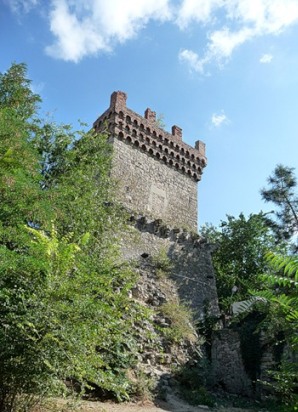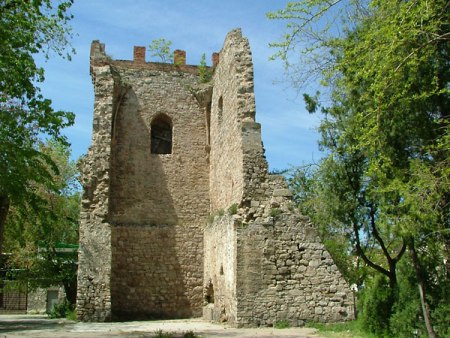

Location: Feodosiya

The Tower of Saint Constantine stands as a striking remnant of the medieval fortifications built by Genoese settlers from the Italian city of Genoa in what is now Feodosiya, Crimea. This imposing structure is located within Yubileyny Park, close to the city's main railway station, offering visitors a glimpse into the region's turbulent past. Originally constructed in 1338 (though some sources cite 1382), the tower was designed to bolster the defenses of the ancient town, then known as Kafa. It formed a crucial part of the outer defensive perimeter, surrounded by a deep, water-filled moat and an earthen rampart that encircled the settlement. Over time, additional protections were added, including a wooden palisade to shield against siege engines. The tower honors the Roman Emperor Constantine the Great, who famously legalized Christianity across his empire in the early 4th century, but it also earned the nickname Arsenal Tower due to its role in storing armaments like halberds, swords, crossbows, spears, arrows, and stone projectiles for catapults.
As one of the pivotal towers in Kafa's extensive defensive network,
the Tower of Saint Constantine anchored the outer belt of
fortifications. From here, the walls extended toward Mount Mithridates
before curving down to the Black Sea, forming a semicircular barrier
around the city. A wide moat fronted the walls, crossed by drawbridges
at the gates that could be raised during threats, securing the
iron-reinforced entrances. The city's rhythm was dictated by these
defenses: gates closed at dusk, halting activity until dawn, often
marked by the call to prayer under later Ottoman rule. Nearby stood the
primary fortress gate, named after Saint George the Victorious during
Genoese control and later renamed Agli-Kapu (Rider's Gate) by the Turks
after their conquest in 1475. This gate, built in 1467 under Consul
Calochero Guizalfa, featured a bridge over the moat; a stone slab
discovered in 1890 commemorates his contributions, including fortress
enhancements and a fountain.
The tower underwent significant
expansions in 1475, when Genoese craftsmen added a barbican—a fortified
gateway—for enhanced protection. Further modifications occurred between
the 15th and 17th centuries, including a stone slope along the coastal
wall to combat wave erosion (as the tower originally hugged the
shoreline) and a baffle wall to deflect cannon fire. Under Ottoman rule,
a semicircular bastion was appended, and a nearby fort was erected. In
the 19th century, during the expansion of Feodosiya's port and railway,
the tower was carefully relocated about 100 meters inland to preserve
it. It saw restorations in 1898 (rebuilding brick merlons) and 1958,
though it sustained damage from shelling during World War II, which
destroyed some battlements. More recently, reports from 2022 indicate
ongoing deterioration since 2016, with masonry collapses and stalled
restoration efforts amid funding issues, highlighting the need for
urgent preservation.
Architecturally, the Tower of Saint Constantine exemplifies medieval military design with its two-tiered, quadrangular form, though it notably features only three walls—a deliberate choice to prevent defenders from being cornered if the fortress fell. Constructed from local limestone, its walls reach up to 2 meters in thickness for durability against assaults. The structure is topped with a distinctive triple arcuate belt (a series of arched machicolations for dropping projectiles on attackers) and merlon spikes, providing cover for archers and crossbowmen. Interfloor ceilings, made from robust oak and beech wood, have not survived, nor has the eastern facade. The adjacent barbican and bastion add layers of complexity, reflecting evolving siege warfare tactics.
Today, the tower remains a prominent landmark in Feodosiya's northern Genoese fortress area, isolated from the main citadel ruins but easily accessible on foot from the tourist hub of Galeriynaya Street. Visitors can approach it closely for inspection and photos, though entry to the interior is prohibited—it's viewable from the exterior only, free of charge, and open 24/7. Reviews from platforms like TripAdvisor give it an average rating of 3.8 out of 5, praising its historical allure and photo opportunities but criticizing its fenced-off state, overgrowth with bushes, crumbling sections, and visible need for repairs, including supportive buttresses. Many suggest a quick stop as part of a broader tour of Feodosiya's sights, ideally via a guided group to learn more context.
Beyond its military role, the Tower of Saint Constantine symbolizes Feodosiya's layered history under Genoese, Ottoman, and later Russian influences. It appears on the city's old coat of arms and has been featured on postage stamps, envelopes, and badges, underscoring its iconic status. As a cultural heritage site, it draws history enthusiasts and serves as a reminder of medieval Crimea's strategic importance in trade and defense routes along the Black Sea.